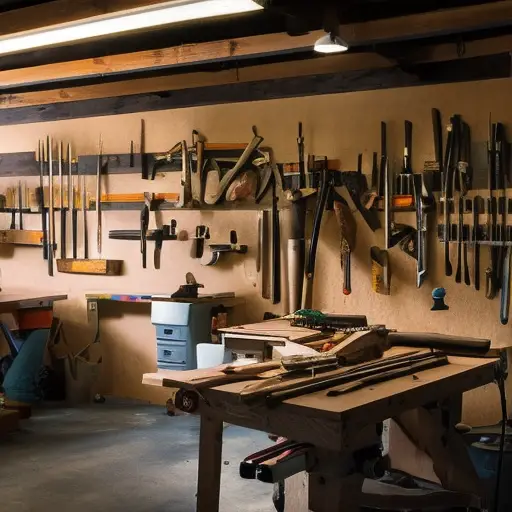The Woodwright’s Shop is a beloved American reality show that has been airing on PBS for over four decades. Hosted by master woodworker and preservationist, Roy Underhill, the show focuses on traditional woodworking techniques and the use of hand tools. The show has been praised for its ability to popularize traditional woodworking and inspire a new generation of woodworkers to take up the craft. With its long-running history and dedicated fanbase, the Woodwright’s Shop is more than just a TV show, it’s a cultural phenomenon that has had a lasting impact on the woodworking community. In this blog post, we will delve into the history of the show, the host, the techniques, the tools, the projects, and the legacy of the show.
Contents
Show Overview
The Woodwright’s Shop is a long-running American television series that has been airing on PBS since 1979. Hosted by Roy Underhill, the show focuses on traditional woodworking techniques and the use of hand tools. The show’s popularity has grown over the years, making it one of the longest-running shows in PBS history.
Roy Underhill has been working with wood since he was a child, and his passion for traditional woodworking techniques led him to become the host of The Woodwright’s Shop. Underhill’s approach to teaching is hands-on and practical, and he encourages viewers to use hand tools and traditional techniques to create beautiful and functional pieces of woodwork. He also has a vast knowledge of the history of tools and how they were used in the past, making the show informative and educational.
The show’s focus on traditional woodworking techniques and hand tools sets it apart from other woodworking shows. The Woodwright’s Shop offers a glimpse into a world where power tools are not the norm, and where the focus is on craftsmanship and skill. Viewers are introduced to techniques such as hand-planing, sawing, and joinery, which have been passed down through generations. These techniques offer a sense of connection to the past and a deeper understanding of the materials and tools used in woodworking. The show has helped to popularize traditional woodworking techniques, sparking renewed interest in them and encouraging the use of hand tools.
The Host: Roy Underhill.
Underhill is a well-known figure in the woodworking community, known for his passion for traditional woodworking techniques and his dedication to preserving them.
Roy Underhill’s background in woodworking began at a young age, starting with small projects and eventually working with more complex pieces. He has trained under some of the most renowned woodworkers of the 20th century and has devoted his life to the preservation of traditional woodworking techniques. He brings his wealth of knowledge and experience to the show, making it an invaluable resource for anyone interested in learning about traditional woodworking.
In addition to being a skilled woodworker and a dedicated teacher, Underhill is also a charismatic host, who has a unique ability to connect with the audience and make the show entertaining. He has a great sense of humor and a relatable personality, which has helped to make the show a beloved staple of the PBS lineup. His dedication to the craft and his approachable demeanor have made him a respected figure in the woodworking community, and his impact on the preservation of traditional woodworking techniques is undeniable.
Traditional Woodworking Techniques
Traditional woodworking techniques featured on the show, such as hand-planing, sawing, and joinery. These techniques are an essential part of traditional woodworking and are used to create beautiful and functional pieces of woodwork.
Hand-planing is a technique used to smooth and shape wood by running a hand plane over the surface. This technique is essential for creating a smooth surface on the wood, and it is also used for shaping the wood to a specific profile. Hand-planing requires a high degree of skill and precision, and it is a technique that is often underappreciated in the modern era of power tools.
Sawing is another technique that is essential to traditional woodworking. It is used to cut wood to a specific size or shape. The show features different types of saws, such as the crosscut saw, the rip saw, and the dovetail saw and shows how they are used to create precise cuts. Sawing by hand requires a high degree of skill and precision, and it is a technique that is often underappreciated in the modern era of power tools.
Joinery is the technique of connecting two pieces of wood together to create a strong and stable joint. The show features different types of joinery such as mortise and tenon, dovetail, and mortise-and-tenon. The show demonstrates how these joints are made and how they are used to create strong and durable pieces of furniture.
These techniques are not only important for the creation of functional and beautiful pieces of the woodwork but also for the preservation of traditional techniques and the connection to the past. The show helps to popularize these techniques and demonstrates their versatility, encouraging viewers to try their hand at traditional woodworking and take on similar projects at home.
Hand Tools
Hand tools used on the show, including planes, saws, chisels, and other traditional woodworking tools. These tools are an essential part of traditional woodworking and are used to create beautiful and functional pieces of woodwork.
Hand planes are a type of tool that is used to smooth and shape wood. They come in different sizes and shapes, each designed for specific tasks. The show features a variety of hand planes, such as the jack plane, the smoothing plane, and the scrub plane, and demonstrates how they are used to create precise and smooth surfaces on the wood.
Saws are another essential tool in traditional woodworking. They come in different shapes and sizes, each designed for specific tasks. The show features different types of saws, such as the crosscut saw, the rip saw, and the dovetail saw, and shows how they are used to create precise cuts.
Chisels are another important tool in traditional woodworking. They come in different shapes and sizes, each designed for specific tasks. The show features different types of chisels, such as the bevel-edge chisel, the mortise chisel, and the paring chisel, and shows how they are used to shape and refine the wood.
Other traditional woodworking tools that are featured on the show include hand drills, spoke shaves, and hand-held routers. These tools are used to create specific shapes and details on the wood, and they are also essential for traditional woodworking.
The use of these hand tools is an essential part of traditional woodworking. They require a high degree of skill and precision, and they are often underappreciated in the modern era of power tools. The show highlights the importance of these tools, and it also provides tips for beginners on how to properly care for and use these tools.
Legacy of “The Woodwright’s Shop”
The show has impacted the woodworking community and the broader public. The show has been airing for over four decades, and it has gained a dedicated fanbase, making it a cultural phenomenon.
The Woodwright’s Shop has played a crucial role in preserving traditional woodworking techniques and encouraging the use of hand tools. The show has helped to popularize these techniques and has sparked renewed interest in them, making them more accessible to the general public. The show has also inspired a new generation of woodworkers to take up the craft and has helped to keep traditional woodworking techniques alive.
The show has also had an impact on the broader public, introducing them to the world of traditional woodworking and the beauty of hand-crafted pieces. The show has helped to raise awareness about the importance of preserving traditional techniques, and it has also helped to educate viewers about the history of woodworking and the tools used to create beautiful pieces of woodwork.
The show’s legacy is not limited to the woodworking community, it is a cultural phenomenon that has had a lasting impact on the broader public. It has provided a valuable resource for anyone interested in learning about traditional woodworking and has helped to keep the craft alive for future generations.
Featured Projects
Projects featured on the show, such as building a wooden chair, a chest of drawers, or a wooden house. These projects demonstrate the versatility of traditional woodworking techniques and how they can be used to create a wide range of objects.
One of the most popular projects featured on the show is the wooden chair. The show demonstrates how to design and build a wooden chair using traditional techniques such as hand-planing, sawing, and joinery. The chair-building process is broken down into manageable steps and is explained in great detail, making it easy for viewers to understand and follow along.
Another popular project featured on the show is the chest of drawers. The show demonstrates how to design and build a chest of drawers using traditional techniques such as hand-planing, sawing, and joinery. The chest of drawers building process is broken down into manageable steps and is explained in great detail, making it easy for viewers to understand and follow along.
The show also features more complex projects such as building a wooden house. This project is a great example of how traditional woodworking techniques can be used to create functional and beautiful structures. The show demonstrates how to design and build a wooden house using traditional techniques such as hand-planing, sawing, and joinery. The process of building a wooden house is broken down into manageable steps and is explained in great detail, making it easy for viewers to understand and follow along.
These projects not only demonstrate the versatility of traditional woodworking but also inspire viewers to try their hand at the hobby and take on similar projects. The show provides a valuable resource for anyone interested in learning about traditional woodworking and the process of creating beautiful and functional pieces from wood.
Here’s a list of some of our favorite projects.
Here is a list of 25 projects that have been featured in “The Woodwright’s Shop”:
- Wooden Chair
- Chest of Drawers
- Wooden House
- Shaker Wall Cabinet
- Tool Chest
- Workbench
- Blanket Chest
- Ladder-back Chair
- Tool Tote
- Trestle Table
- Windsor Chair
- Roubo Workbench
- Morris Chair
- Hand-planing a surface
- Sharpening Chisels
- Wooden Clock
- Wooden Toy
- Windsor Rocking Chair
- Hand-sawn Mirror Frame
- Wooden Spoons
- Wooden Mallet
- Wooden Lidded Box
- Wooden Picture Frame
- Wooden Jewelry Box
- Wooden Candlesticks
Where can you watch Woodright’s shop?
New episodes appear on your local PBS channel. Older episodes are also listed on YouTube . We’ve included a link to one of their video playlists.
Conclusion
“The Woodwright’s Shop” is a valuable resource for anyone interested in traditional woodworking and the preservation of traditional techniques. The show has been on the air for decades and has covered a wide range of projects, from simple wooden toys to complex pieces of furniture. The host, Roy Underhill, is a master of traditional woodworking techniques and his passion for the craft is evident in every episode.
The show is not only about the construction of beautiful and functional pieces, but also about the history, the tools, and the techniques that are used in traditional woodworking. The show is a great way to learn new techniques, get inspiration for projects, and to connect with the woodworking community.




